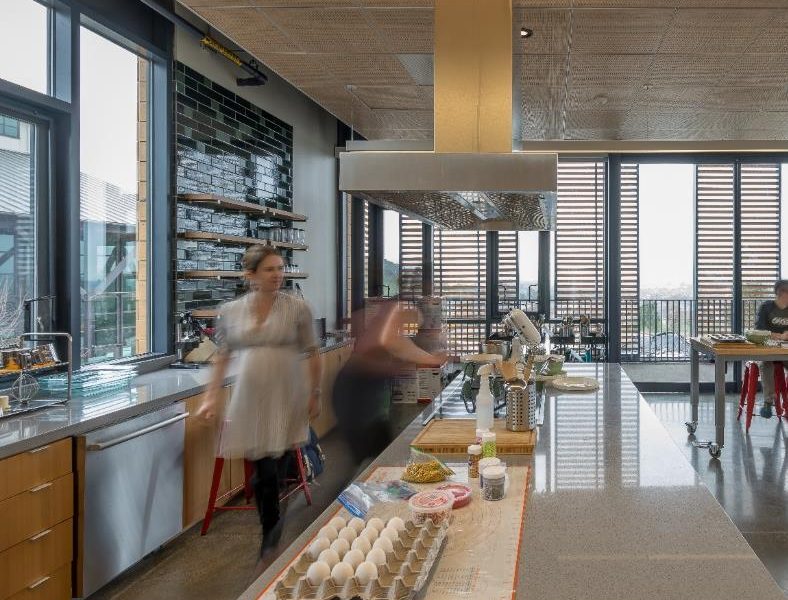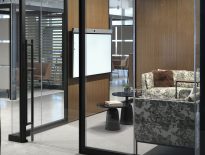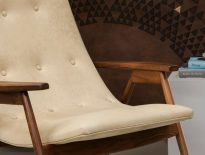When resource choices drive big goals
One of the Living Future theories of change is that all our work reverberates. The ripple effects of the Sonoma Academy Guild & Commons — which were Petal Certified and Zero Carbon Certified in 2021 — are powerful and subtle. First and foremost, of course, as an education project — the academy is a college preparatory school in Santa Rosa, California — there is the fact that nearly every element, material, and service does something to teach about a more sustainable, resilient, equitable, and community-forward approach. This project exemplifies the principles of the Beauty Petal, which celebrates “design that uplifts the human spirit” and promotes broader societal change. It also serves as an illustration of regenerative design for a living future.
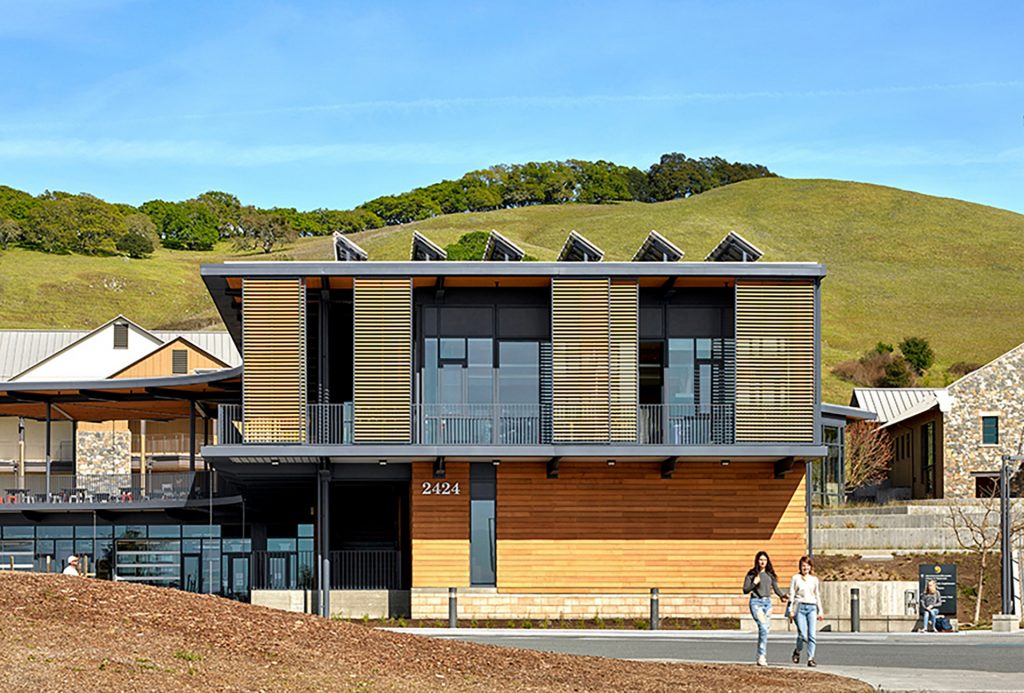
This project program is a student center, community gathering, and dining commons, teaching kitchen and garden, and indoor/outdoor maker spaces. The school leadership and design team’s commitment to making this an all-electric project turned out to have immense ripple effects. “Creating a Net Zero Energy, all-electric project that included a commercial grade kitchen and a maker space was not something that everyone thought would be possible at first,” says Pauline Souza, principal with WRNS, the architects on the project. She credits the collaboration with Hormoz Janssens, David Kanada, and others for helping to realize this vision.
This was one of the first all-electric commercial kitchens with induction cooking in the country. The prep area has copious daylight and operable windows, and the kitchen area is on display to the community gathering/dining space. The food service operator, Flick/Compass, was uncertain at first about how cooking with induction would work for their processes and concerned about efficiency and effectiveness. “But they really came around,” says Souza. “This is a small kitchen, but after we worked with that team, it has become ‘the little kitchen that could.’ Since its completion, many companies and organizations have come to see how it works. This includes folks from Microsoft.” Pauline explains that this kitchen became an induction cooking proof of concept.
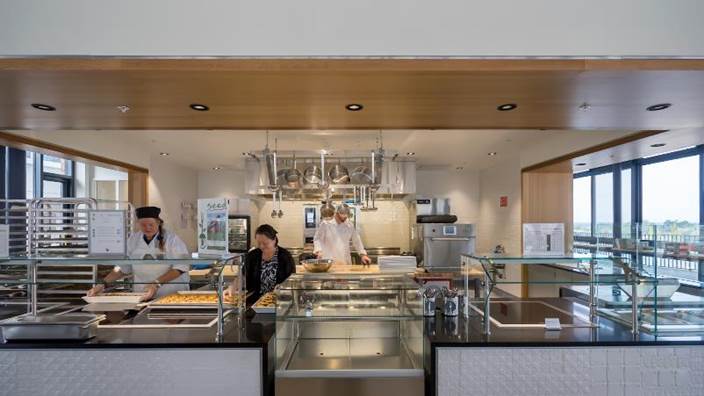
Rick Theis was on the Sonoma Academy board during the project’s development and through construction and early occupancy. He was also Chair of the Buildings and Ground Committee and helped write the school’s Sustainability Guidelines. He recalls giving many tours of the project to people who could “hardly believe seeing a fossil fuel-free commercial kitchen with no gas range,” he says. “Seeing an induction wok that could get hotter than one fired by gas really amazed them.” Design teams brought their clients to see the Sonoma Academy kitchen in action — and reassured them about the effectiveness of induction cooking.
The induction cooking choice relates to the bigger missions of beauty and education. “We were able to show how the induction cooking allowed us to downscale the mechanical because there is less heat and much more. The choice became both a driver and a liberator for form. The space, though small, seems expansive, and the connection to the site is strong. It might not seem like a piece of kitchen equipment could be a design driver, allowing us to reach for the Beauty Petal, but these things are connected.”
From the project’s Beauty imperative:
The resultant design strengthens the strong sense of place apparent in the school and tells the story of the region’s architecture, landscape, people, sustainability, and everyday life.
In today’s techno-centric world, people spend more time looking down at devices versus connecting to their place. For Sonoma Academy, a high school on the outskirts of Santa Rosa, their goal was to have people look up and out, to create a campus heart, and to bring the school and community together through dining and making, all while celebrating the region’s beauty.
The beauty of the site inspired the organization of two sweeping floors that stretch to views, grab onto the hillside, and work to blend this campus with many levels. With the open sliding doors, students are encouraged to wander in and through, making this building a part of everyday pathways. Exposing the materials, the radiant manifolds, the structure, and the systems invite the user into the daily functions of the building. Biophilic principles providing guidance for planning and material selection – everything was thought of as a critical piece of the story.
From the project’s Inspiration and Education imperative:
Sonoma Academy also has launched a Connections program that brings the principles of sustainability into the classroom curriculum. The 9th-grade program includes classes such as Literature of the Environmental Movement and Environmental Science, and an Exploratory course revolving around food and the garden, just to name a few.
Additionally, Sonoma Academy holds Open Houses and campus tours to prospective student families as well as Community Fundraiser events. These Open Houses and fundraising events are held multiple times a year and are open to all. The project’s educational brochure is provided at the open house and highlights the building’s design and environmental features.
Another area that had an immense ripple effect was the project’s work on the Materials Petal. “It took us a long time and deep work to get there,” Souza said, “but the effort has changed our process and our understanding of engagement in the industry.” She explains that the team did a deep dive into material health for this project, and that has unrolled into several other projects. “I was moved by how the act of doing the hard work really changed us and inspired us to go farther. It was a lot of granular effort at the time but it was really exhilarating, too. We are still riding this wave of inspiration even now. We have worked with a lot of rating systems and standards, and I have not experienced this kind of shift in any other case.”
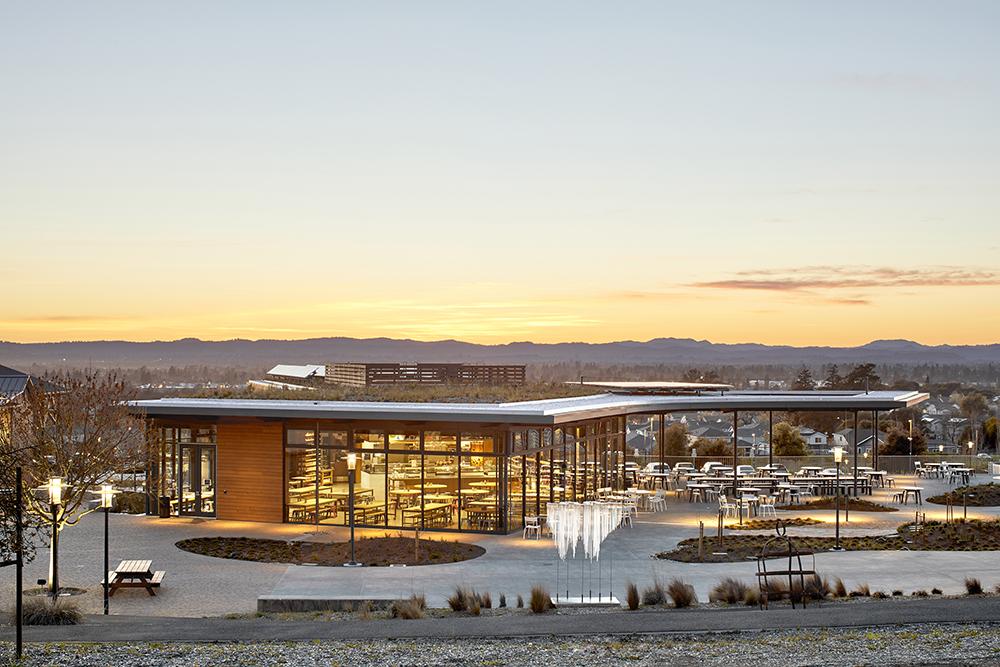
This project had the “all in” feel to it that can result in innovative solutions. For example, Souza explains, “We were able to add PV and a green roof — not just one or the other. This was important because this building is nestled into the site and the roof is highly visible from other levels. This is one of the special ‘beauty moves’ that we were able to realize, thanks to the persistence and care of the entire time.”
Indeed, the beauty of this project is partly a result of the fact that the design team conceived it as a building of its site. The sense of it being of its place is palpable. And Souza says it not only looks like that, but it feels like that, too. “It really doesn’t feel like it was ‘shipped in.’ It feels like it is from this place and belongs here. The materials are humble and tactile: wood paneling, green roof.” The result is a biophilic building — the beauty of the project feels more like land than sculpture upon it.
RELATED LINKS
https://living-future.org/case-studies/sonoma-academy-guild-commons/
Living Future is able to support projects like these and share their stories with the world thanks to contributions like yours. Please donate to help us continue to build a living future.
Cover photo © Celso Rojas
